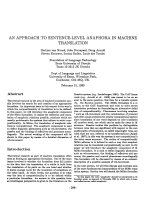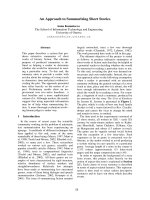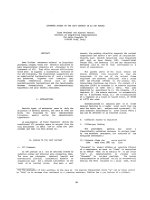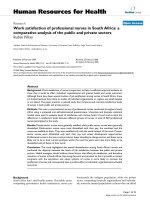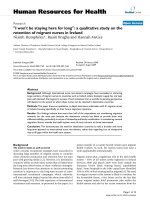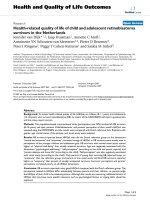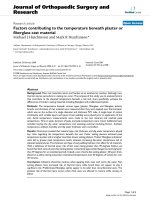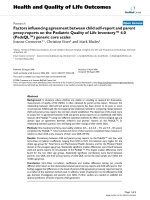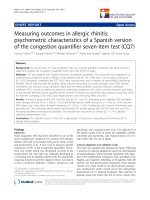Báo cáo toán học: " An introduction to 2-fuzzy n-normed linear spaces and a new perspective to the Mazur-Ulam problem" docx
Bạn đang xem bản rút gọn của tài liệu. Xem và tải ngay bản đầy đủ của tài liệu tại đây (282.41 KB, 39 trang )
Journal of Inequalities and
Applications
This Provisional PDF corresponds to the article as it appeared upon acceptance. Fully formatted
PDF and full text (HTML) versions will be made available soon.
An introduction to 2-fuzzy n-normed linear spaces and a new perspective to the
Mazur-Ulam problem
Journal of Inequalities and Applications 2012, 2012:14
doi:10.1186/1029-242X-2012-14
Choonkil Park ()
Cihangir Alaca ()
ISSN
Article type
1029-242X
Research
Submission date
24 May 2011
Acceptance date
19 January 2012
Publication date
19 January 2012
Article URL
/>
This peer-reviewed article was published immediately upon acceptance. It can be downloaded,
printed and distributed freely for any purposes (see copyright notice below).
For information about publishing your research in Journal of Inequalities and Applications go to
/>For information about other SpringerOpen publications go to
© 2012 Park and Alaca ; licensee Springer.
This is an open access article distributed under the terms of the Creative Commons Attribution License ( />which permits unrestricted use, distribution, and reproduction in any medium, provided the original work is properly cited.
An introduction to 2-fuzzy
n-normed linear spaces and a new
perspective to the Mazur–Ulam
problem
Choonkil Park1 and Cihangir Alaca∗2
1 Department
of Mathematics, Research Institute for Natural Sciences,
Hanyang University, Seoul 133-791, Korea
2 Department
of Mathematics, Faculty of Science and Arts,
Celal Bayar University, 45140 Manisa, Turkey
∗ Corresponding
author:
Email address:
CP:
1
Abstract
The purpose of this article is to introduce the concept of 2-fuzzy
n-normed linear space or fuzzy n-normed linear space of the set
of all fuzzy sets of a non-empty set. We define the concepts of nisometry, n-collinearity, n-Lipschitz mapping in this space. Also,
we generalize the Mazur–Ulam theorem, that is, when X is a 2fuzzy n-normed linear space or
(X) is a fuzzy n-normed linear
space, the Mazur–Ulam theorem holds. Moreover, it is shown that
each n-isometry in 2-fuzzy n-normed linear spaces is affine.
Mathematics Subject Classification (2010): 03E72; 46B20;
51M25; 46B04; 46S40.
Keywords: Mazur–Ulam theorem; α-n-norm; 2-fuzzy n-normed
linear spaces; n-isometry; n-Lipschitz mapping.
1. Introduction
A satisfactory theory of 2-norms and n-norms on a linear space has
been introduced and developed by Găhler [1, 2]. Following Misiak [3],
a
Kim and Cho [4], and Malˇeski [5] developed the theory of n-normed
c
space. In [6], Gunawan and Mashadi gave a simple way to derive an
(n−1)-norm from the n-norms and realized that any n-normed space is
an (n − 1)-normed space. Different authors introduced the definitions
of fuzzy norms on a linear space. Cheng and Mordeson [7] and Bag
and Samanta [8] introduced a concept of fuzzy norm on a linear space.
The concept of fuzzy n-normed linear spaces has been studied by many
authors (see [4, 9]).
Recently, Somasundaram and Beaula [10] introduced the concept of
2-fuzzy 2-normed linear space or fuzzy 2-normed linear space of the set
of all fuzzy sets of a set. The authors gave the notion of α-2-norm on a
linear space corresponding to the 2-fuzzy 2-norm by using some ideas
of Bag and Samanta [8] and also gave some fundamental properties of
this space.
In 1932, Mazur and Ulam [11] proved the following theorem.
Mazur–Ulam Theorem. Every isometry of a real normed linear
space onto a real normed linear space is a linear mapping up to translation.
Baker [12] showed an isometry from a real normed linear space into
a strictly convex real normed linear space is affine. Also, Jian [13]
investigated the generalizations of the Mazur–Ulam theorem in F ∗ spaces. Rassias and Wagner [14] described all volume preserving mappings from a real finite dimensional vector space into itself and Văisălă
a aa
[15] gave a short and simple proof of the Mazur–Ulam theorem. Chu
[16] proved that the Mazur–Ulam theorem holds when X is a linear
2-normed space. Chu et al. [17] generalized the Mazur–Ulam theorem
when X is a linear n-normed space, that is, the Mazur–Ulam theorem holds, when the n-isometry mapped to a linear n-normed space is
ˇ
affine. They also obtain extensions of Rassias and Semrl’s theorem [18].
Moslehian and Sadeghi [19] investigated the Mazur–Ulam theorem in
non-archimedean spaces. Choy et al. [20] proved the Mazur–Ulam theorem for the interior preserving mappings in linear 2-normed spaces.
They also proved the theorem on non-Archimedean 2-normed spaces
over a linear ordered non-Archimedean field without the strict convexity assumption. Choy and Ku [21] proved that the barycenter of
triangle carries the barycenter of corresponding triangle. They showed
the Mazur–Ulam problem on non-Archimedean 2-normed spaces using
the above statement. Xiaoyun and Meimei [22] introduced the concept
of weak n-isometry and then they got under some conditions, a weak
n-isometry is also an n-isometry. Cobza¸ [23] gave some results of the
s
Mazur–Ulam theorem for the probabilistic normed spaces as defined by
Alsina et al. [24]. Cho et al. [25] investigated the Mazur–Ulam theorem
on probabilistic 2-normed spaces. Alaca [26] introduced the concepts of
2-isometry, collinearity, 2-Lipschitz mapping in 2-fuzzy 2-normed linear
spaces. Also, he gave a new generalization of the Mazur–Ulam theorem
when X is a 2-fuzzy 2-normed linear space or (X) is a fuzzy 2-normed
linear space. Kang et al. [27] proved that the Mazur–Ulam theorem
holds under some conditions in non-Archimedean fuzzy normed space.
Kubzdela [28] gave some new results for isometries, Mazur–Ulam theorem and Aleksandrov problem in the framework of non-Archimedean
normed spaces. The Mazur–Ulam theorem has been extensively studied by many authors (see [29, 30]).
In the present article, we introduce the concept of 2-fuzzy n-normed
linear space or fuzzy n-normed linear space of the set of all fuzzy sets of
a non-empty set. We define the concepts of n-isometry, n-collinearity,
n-Lipschitz mapping in this space. Also, we generalize the Mazur–
Ulam theorem, that is, when X is a 2-fuzzy n-normed linear space
or
(X) is a fuzzy n-normed linear space, the Mazur–Ulam theorem
holds. It is moreover shown that each n-isometry in 2-fuzzy n-normed
linear spaces is affine.
2. Preliminaries
Definition 2.1([31]) Let n ∈ N and let X be a real vector space of
dimension d ≥ n. (Here we allow d to be infinite.) A real-valued
function •, . . . , • on X × · · · × X satisfying the following properties
n
(1) x1 , x2 , . . . , xn
= 0 if and only if x1 , x2 , . . . , xn are linearly
dependent,
(2) x1 , x2 , . . . , xn is invariant under any permutation,
(3) x1 , x2 , . . . , αxn = |α| x1 , x2 , . . . , xn for any α ∈ R,
(4) x1 , x2 , . . . , xn−1 , y + z ≤ x1 , x2 , . . . , xn−1 , y + x1 , x2 , . . . , xn−1 , z ,
is called an n-norm on X and the pair (X, •, . . . , • ) is called an
n-normed linear space.
Definition 2.2 [9] Let X be a linear space over S (field of real or
complex numbers). A fuzzy subset N of X n × R (R, the set of real
numbers) is called a fuzzy n-norm on X if and only if:
(N1) For all t ∈ R with t ≤ 0, N (x1 , x2 , . . . , xn , t) = 0,
(N2) For all t ∈ R with t > 0, N (x1 , x2 , . . . , xn , t) = 1 if and only if
x1 , x2 , . . . , xn are linearly dependent,
(N3) N (x1 , x2 , . . . , xn , t) is invariant under any permutation of x1 ,
x2 , . . . , x n ,
t
(N4) For all t ∈ R with t > 0, N (x1 , x2 , . . . , λxn , t) = N (x1 , x2 , . . . , xn , λ ),
if λ = 0, λ ∈ S,
(N5) For all s, t ∈ R
N (x1 , x2 , . . . , xn +xn , s+t) ≥ min {N (x1 , x2 , . . . , xn , s), N (x1 , x2 , . . . , xn , t)},
(N6) N (x1 , x2 , . . . , xn , t) is a non-decreasing function of t ∈ R and
lim N (x1 , x2 , . . . , xn , t) = 1.
t→∞
Then (X, N ) is called a fuzzy n-normed linear space or in short f n-NLS.
Theorem 2.1 [9] Let (X, N ) be an f -n-NLS. Assume that
(N7) N (x1 , x2 , . . . , xn , t) > 0 for all t > 0 implies that x1 , x2 , . . . , xn
are linearly dependent.
Define
x1 , x 2 , . . . , x n
Then { •, •, . . . , •
α
= inf {t : N (x1 , x2 , . . . , xn , t) ≥ α, α ∈ (0, 1)} .
α
: α ∈ (0, 1)} is an ascending family of n-norms on
X.
We call these n-norms as α-n-norms on X corresponding to the fuzzy
n-norm on X.
Definition 2.3 Let X be any non-empty set and
fuzzy sets on X. For U, V ∈
(X) the set of all
(X) and λ ∈ S the field of real numbers,
define
U + V = {(x + y, ν ∧ µ) : (x, ν) ∈ U, (y, µ) ∈ V }
and λU = {(λx, ν) : (x, ν) ∈ U }.
Definition 2.4 A fuzzy linear space X = X × (0, 1] over the number
field S, where the addition and scalar multiplication operation on X
are defined by (x, ν)+(y, µ) = (x+y, ν ∧µ), λ(x, ν) = (λx, ν) is a fuzzy
normed space if to every (x, ν) ∈ X there is associated a non-negative
real number, (x, ν) , called the fuzzy norm of (x, ν), in such away that
(i) (x, ν) = 0 iff x = 0 the zero element of X, ν ∈ (0, 1],
(ii) λ(x, ν) = |λ| (x, ν) for all (x, ν) ∈ X and all λ ∈ S,
(iii) (x, ν) + (y, µ) ≤ (x, ν ∧ µ) + (y, ν ∧ µ) for all (x, ν), (y, µ) ∈
X,
(iv) (x, ∨t νt ) = ∧t (x, νt ) for all νt ∈ (0, 1].
3. 2-fuzzy n-normed linear spaces
In this section, we define the concepts of 2-fuzzy n-normed linear spaces
and α-n-norms on the set of all fuzzy sets of a non-empty set.
Definition 3.1 Let X be a non-empty and
fuzzy sets in X. If f ∈
(X) be the set of all
(X) then f = {(x, µ) : x ∈ X and µ ∈ (0, 1]}.
Clearly f is bounded function for |f (x)| ≤ 1. Let S be the space of
real numbers, then
(X) is a linear space over the field S where the
addition and scalar multiplication are defined by
f + g = {(x, µ) + (y, η)} = {(x + y, µ ∧ η) : (x, µ) ∈ f and (y, η) ∈ g}
and
λf = {(λx, µ) : (x, µ) ∈ f }
where λ ∈ S.
The linear space
f ∈
(X) is said to be normed linear space if, for every
(X), there exists an associated non-negative real number f
(called the norm of f ) which satisfies
(i) f = 0 if and only if f = 0. For
f
= 0
⇐⇒ { (x, µ) : (x, µ) ∈ f } = 0
⇐⇒ x = 0, µ ∈ (0, 1] ⇐⇒ f = 0.
(ii) λf = |λ| f , λ ∈ S. For
λf = { λ(x, µ) : (x, µ) ∈ f , λ ∈ S}
= {|λ| (x, µ) : (x, µ) ∈ f } = |λ| f .
(iii) f + g ≤ f + g for every f, g ∈
(X). For
f + g = { (x, µ) + (y, η) : x, y ∈ X, µ, η ∈ (0, 1]}
= { (x + y), (µ ∧ η) : x, y ∈ X, µ, η ∈ (0, 1]}
= { (x, µ ∧ η) + (y, µ ∧ η) : (x, µ) ∈ f , (y, η) ∈ g}
= f + g .
Then ( (X), • ) is a normed linear space.
Definition 3.2 A 2-fuzzy set on X is a fuzzy set on
(X).
Definition 3.3 Let X be a real vector space of dimension d ≥ n
(n ∈ N) and
(X) be the set of all fuzzy sets in X. Here we allow
d to be infinite. Assume that a [0, 1]-valued function ã, . . . , ã on
(X) ì · · · × (X) satisfies the following properties
n
(1) f1 , f2 , . . . , fn = 0 if and only if f1 , f2 , . . . , fn are linearly dependent,
(2) f1 , f2 , . . . , fn is invariant under any permutation,
(3) f1 , f2 , . . . , λfn = |λ| f1 , f2 , . . . , fn for any λ ∈ S,
(4) f1 , f2 , . . . , fn−1 , y + z ≤ f1 , f2 , . . . , fn−1 , y + f1 , f2 , . . . , fn−1 , z .
Then ( (X), •, . . . , • ) is an n-normed linear space or (X, •, . . . , • )
is a 2-n-normed linear space.
Definition 3.4 Let
fuzzy subset N of
(X) be a linear space over the real field S. A
(X) × · · · × (X) × R is called a 2-fuzzy n-norm
on X (or fuzzy n-norm on
n
(X)) if and only if
(2-N1) for all t ∈ R with t ≤ 0, N (f1 , f2 , . . . , fn , t) = 0,
(2-N2) for all t ∈ R with t > 0, N (f1 , f2 , . . . , fn , t) = 1 if and only if
f1 , f2 , . . . , fn are linearly dependent,
(2-N3) N (f1 , f2 , . . . , fn , t) is invariant under any permutation of f1 ,
f2 , . . . , f n ,
(2-N4) for all t ∈ R with t > 0, N (f1 , f2 , . . . , λfn , t) = N (f1 , f2 , . . . , fn , t/ |λ|),
if λ = 0, λ ∈ S,
(2-N5) for all s, t ∈ R,
N (f1 , f2 , . . . , fn +fn , s+t) ≥ min{N (f1 , f2 , . . . , fn , s), N (f1 , f2 , . . . , fn , t)},
(2-N6) N (f1 , f2 , . . . , fn , ·) : (0, ∞) → [0, 1] is continuous,
(2-N7) lim N (f1 , f2 , . . . , fn , t) = 1.
t→∞
Then ( (X), N ) is a fuzzy n-normed linear space or (X, N ) is a
2-fuzzy n-normed linear space.
Remark 3.1 In a 2-fuzzy n-normed linear space (X, N ), N (f1 , f2 , . . . , fn , ·)
is a non-decreasing function of R for all f1 , f2 , . . . , fn ∈
(X).
Remark 3.2 From (2-N4) and (2-N5), it follows that in a 2-fuzzy
n-normed linear space,
t
(2-N4) for all t ∈ R with t > 0, N (f1 , f2 , . . . , λfi , . . . , fn , t) = N f1 , f2 , . . . , fi , . . . , fn , |λ| ,
if λ = 0, λ ∈ S,
(2-N5) for all s, t ∈ R,
N (f1 , f2 , . . . , fi + fi , . . . , fn , s + t)
≥ min{N (f1 , f2 , . . . , fi , . . . , fn , s), N (f1 , f2 , . . . , fi , . . . , fn , t)}.
The following example agrees with our notion of 2-fuzzy n-normed
linear space.
Example 3.1 Let ( (X), •, •, . . . , • ) be an n-normed linear space
as in Definition 3.3. Define
N (f1 , f2 , . . . , fn , t) =
for all (f1 , f2 , . . . , fn ) ∈
n-normed linear space.
t
t+ f1 ,f2 ,...,fn
0
if t > 0, t ∈ R,
if
t≤0
(X) × · · · × (X). Then (X, N ) is a 2-fuzzy
n
Solution. (2-N1) For all t ∈ R with t ≤ 0, by definition, we have
N (f1 , f2 , . . . , fn , t) = 0.
(2-N2) For all t ∈ R with t > 0,
N (f1 , f2 , . . . , fn , t) = 1 ⇐⇒
t
=1
t + f1 , f 2 , . . . , f n
⇐⇒ t = t + f1 , f2 , . . . , fn
⇐⇒ f1 , f2 , . . . , fn = 0
⇐⇒ f1 , f2 , . . . , fn are linearly dependent.
(2-N3) For all t ∈ R with t > 0,
N (f1 , f2 , . . . , fn , t) =
t
t
=
t + f1 , f2 , . . . , fn
t + f1 , f2 , . . . , fn , fn−1
= N (f1 , f2 , . . . , fn , fn−1 , t) = · · · .
(2-N4) For all t ∈ R with t > 0 and λ ∈ F , λ = 0,
N (f1 , f2 , . . . , fn , t/ |λ|) =
t/ |λ|
t/ |λ| + f1 , f2 , . . . , fn
=
t/ |λ|
(t + |λ| f1 , f2 , . . . , fn ) / |λ|
=
t
t + |λ| f1 , f2 , . . . , fn
=
t
= N (f1 , f2 , . . . , λfn , t).
t + f1 , f2 , . . . , λfn
(2-N5) We have to prove
N (f1 , f2 , . . . , fn +fn , s+t) ≥ min{f (x1 , f2 , . . . , fn , s), N (f1 , f2 , . . . , fn , t)}.
(i) s + t < 0,
(ii) s = t = 0,
(iii) s + t > 0; s > 0, t < 0; s < 0, t > 0, then the above relation is
obvious. If
(iv) s > 0, t > 0, s + t > 0, then
N (f1 , f2 , . . . , fn + fn , s + t) =
s+t
.
s + t + f1 , f 2 , . . . , f n + fn
If
s
s + f1 , f 2 , . . . , f n
≥
=⇒
t
f1 , f2 , . . . , fn
x1 , x 2 , . . . , x n
=⇒
≤
t + f1 , f 2 , . . . , f n
s
t
f1 , f 2 , . . . , f n
f1 , f 2 , . . . , f n
f1 , f 2 , . . . , f n
+
≤
s
s
t
+
f1 , f2 , . . . , fn
s
=⇒
f1 , f2 , . . . , fn + fn
≤
s
=⇒
f1 , f2 , . . . , fn + fn
f1 , f 2 , . . . , f n
≤
s+t
t
s+t
s·t
f1 , f 2 , . . . , f n
=⇒
s + t + f1 , f 2 , . . . , f n + fn
t + f1 , f 2 , . . . , f n
≤
s+t
t
=⇒
s+t
t
≥
s + t + f1 , f 2 , . . . , f n + fn
t + f1 , f 2 , . . . , f n
=⇒ N (f1 , f2 , . . . , fn + fn , s + t) ≥ N (f1 , f2 , . . . , fn , t).
Similarly, if
t
s
≥
t + f1 , f 2 , . . . , f n
s + f1 , f 2 , . . . , f n
=⇒ N (f1 , f2 , . . . , fn + fn , s + t) ≥ N (f1 , f2 , . . . , fn , t).
Thus
N (f1 , f2 , . . . , fn +fn , s+t) ≥ min{N (f1 , f2 , . . . , fn , s), N (f1 , f2 , . . . , fn , t)}.
(2-N6) It is clear that N (f1 , f2 , . . . , fn , ·) : (0, ∞) → [0, 1] is continuous.
(2-N7) For all t ∈ R with t > 0,
lim N (f1 , f2 , . . . , fn , t) = lim
t→∞
t→∞
t
t + f1 , f 2 , . . . , f n
t
= 1,
t→∞ t(1 + (1/t) f1 , f2 , . . . , fn )
= lim
as desired.
As a consequence of Theorem 3.2 in [10], we introduce an interesting
notion of ascending family of α-n-norms corresponding to the fuzzy
n-norms in the following theorem.
Theorem 3.1 Let ( (X), N ) is a fuzzy n-normed linear space. Assume that
(2-N8) N (f1 , f2 , . . . , fn , t) > 0 for all t > 0 implies f1 , f2 , . . . , fn are
linearly dependent.
Define
f1 , f 2 , . . . , f n
Then { •, •, . . . , •
α
= inf {t : N (f1 , f2 , . . . , fn , t) ≥ α, α ∈ (0, 1)} .
α
: α ∈ (0, 1)} is an ascending family of n-norms on
(X).
These n-norms are called α-n-norms on
2-fuzzy n-norm on X.
(X) corresponding to the
Proof. (i) Let f1 , . . . , fn
α
= 0. This implies that inf {t : N (f1 , . . . , fn , t) ≥ α}.
Then, N (f1 , f2 , . . . , fn , t) ≥ α > 0, for all t > 0, α ∈ (0, 1), which implies that f1 , f2 , . . . , fn are linearly dependent, by (2-N8).
Conversely, assume f1 , f2 , . . . , fn are linearly dependent. This implies that N (f1 , f2 , . . . , fn , t) = 1 for all t > 0. For all α ∈ (0, 1),
inf {t : N (f1 , f2 , . . . , fn , t) ≥ α}, which implies that f1 , f2 , . . . , fn
α
=
0.
(ii) Since N (f1 , f2 , . . . , fn , t) is invariant under any permutation,
f1 , f 2 , . . . , f n
= 0 under any permutation.
α
(iii) If λ = 0, then
f1 , f2 , . . . , λfn
α
= inf{s : N (f1 , f2 , . . . , fn , s) ≥ α}
= inf{s : N (f1 , f2 , . . . , fn ,
Let t =
s
,
|λ|
s
) ≥ α }.
|λ|
then
f1 , f2 , . . . , λfn
α
= inf{|λ| t : N (f1 , f2 , . . . , fn , t) ≥ α}
= |λ| inf{t : N (f1 , f2 , . . . , fn , t) ≥ α} = |λ| f1 , f2 , . . . , fn
If λ = 0, then
f1 , f2 , . . . , λfn
α
= f1 , f 2 , . . . , 0
α
= 0 = 0 f1 , f 2 , . . . , f n
= |λ| f1 , f2 , . . . , fn
α
, ∀λ ∈ S (field).
α
α
.
(iv)
f1 , f 2 , . . . , f n
α
+ f1 , f2 , . . . , fn ||α
= inf{t : N (f1 , f2 , . . . , fn , t) ≥ α} + inf{s : N (f1 , f2 , . . . , fn , s) ≥ α}
= inf{t + s : N (f1 , f2 , . . . , fn , t) ≥ α, N (f1 , f2 , . . . , fn , s) ≥ α}
≥ inf {t + s : N (f1 , f2 , . . . , fn + fn , t + s) ≥ α} ,
≥ inf {r : N (f1 , f2 , . . . , fn + fn , r) ≥ α} , r = t + s
= f1 , f2 , . . . , fn + fn
α
.
Hence
f1 , f 2 , . . . , f n + fn
Thus { •, •, . . . , •
α
α
≤ f1 , f2 , . . . , fn
α
+ f1 , f2 , . . . , fn
α
.
: α ∈ (0, 1)} is an α-n-norm on X.
Let 0 < α1 < α2 . Then,
f1 , f 2 , . . . , f n
α1
= inf{t : N (f1 , f2 , . . . , fn , t) ≥ α1 },
f1 , f 2 , . . . , f n
α2
= inf{t : N (f1 , f2 , . . . , fn , t) ≥ α2 }.
As α1 < α2 ,
{t : N (f1 , f2 , . . . , fn , t) ≥ α2 } ⊂ {t : N (f1 , f2 , . . . , fn , t) ≥ α1 }
implies that
inf{t : N (f1 , f2 , . . . , fn , t) ≥ α2 } ≥ inf{t : N (f1 , f2 , . . . , fn , t) ≥ α1 }
which implies that
f1 , f2 , . . . , fn
Hence { •, •, . . . , •
α
α2
≥ f1 , f 2 , . . . , f n
α1
.
: α ∈ (0, 1)} is an ascending family of α-n-norms
on x corresponding to the 2-fuzzy n-norm on X.
4. On the Mazur–Ulam problem
In this section, we give a new generalization of the Mazur–Ulam theorem when X is a 2-fuzzy n-normed linear space or
(X) is a fuzzy
n-normed linear space. Hereafter, we use the notion of fuzzy n-normed
linear space on
(X) instead of 2-fuzzy n-normed linear space on X.
Definition 4.1 Let (X) and (Y ) be fuzzy n-normed linear spaces
and Ψ :
(X) →
(Y ) a mapping. We call Ψ an n-isometry if
f1 − f0 , . . . , f n − f0
α
for all f0 , f1 , f2 , . . . , fn ∈
= Ψ (f1 ) − Ψ (f0 ) , . . . , Ψ (fn ) − Ψ (f0 )
(X) and α, β ∈ (0, 1).
β
For a mapping Ψ, consider the following condition which is called
the n-distance one preserving property (nDOPP).
(nDOPP) Let f0 , f1 , f2 , . . . , fn ∈
(X) with f1 − f0 , . . . , fn − f0
Then Ψ (f1 ) − Ψ (f0 ) , . . . , Ψ (fn ) − Ψ (f0 )
Lemma 4.1 Let f1 , f2 , . . . , fn ∈
f1 , . . . , f i , . . . , f j , . . . , f n
α
β
α
= 1.
= 1.
(X), α ∈ (0, 1) and
∈ R. Then,
= f1 , . . . , f i , . . . , f j + fi , . . . , f n
α
for all 1 ≤ i = j ≤ n.
Proof. It is obviously true.
Lemma 4.2 For f0 , f0 ∈
(X), if f0 and f0 are linearly dependent
with some direction, that is, f0 = tf0 for some t > 0, then
f0 + f0 , f 1 , . . . , f n
for all f1 , f2 , . . . , fn ∈
α
= f0 , f 1 , . . . , f n
α
+ f0 , f 1 , . . . , f n
(X) and α ∈ (0, 1).
Proof. Let f0 = tf0 for some t > 0. Then we have
f0 + f0 , f 1 , . . . , f n
α
= f0 + tf0 , f1 , . . . , fn
= (1 + t) f0 , f1 , . . . , fn
α
α
α
= f0 , f 1 , . . . , f n
α
+ t f0 , f 1 , . . . , f n
= f0 , f 1 , . . . , f n
α
+ f0 , f 1 , . . . , f n
for all f1 , f2 , . . . , fn ∈
α
α
(X) and α ∈ (0, 1).
Definition 4.2 The elements f0 , f1 , f2 , . . . , fn of (X) are said to be
n-collinear if for every i, {fj − fi : 0 ≤ j = i ≤ n} is linearly dependent.
Remark 4.1 The elements f0 , f1 , and f2 are said to be 2-collinear
if and only if f2 − f0 = r(f1 − f0 ) for some real number r.
Now we define the concept of n-Lipschitz mapping.
Definition 4.3 We call Ψ an n-Lipschitz mapping if there is a κ ≥ 0
such that
Ψ (f1 ) − Ψ (f0 ) , . . . , Ψ (fn ) − Ψ (f0 )
for all f0 , f1 , f2 , . . . , fn ∈
β
≤ κ f1 − f0 , . . . , f n − f0
α
(X) and α, β ∈ (0, 1). The smallest such κ
is called the n-Lipschitz constant.
Lemma 4.3 Assume that if f0 , f1 , and f2 are 2 -collinear then Ψ (f0 ) ,
Ψ (f1 ) and Ψ (f2 ) are 2-collinear, and that Ψ satisfies (nDOPP). Then
Ψ preserves the n-distance k for each k ∈ N.
Proof. Suppose that there exist f0 , f1 ∈
(X) with f0 = f1 such that
Ψ (f0 ) = Ψ (f1 ). Since dim (X) ≥ n, there are f2 , . . . , fn ∈
(X)
such that f1 − f0 , f2 − f0 , . . . , fn − f0 are linearly independent. Since
f1 − f0 , f 2 − f0 , . . . , f n − f0
z 2 = f0 +
α
= 0, we can set
f2 − f0
f1 − f0 , f 2 − f0 , . . . , f n − f0
.
α
Then we have
f1 − f0 , z2 − f0 , f3 − f0 , . . . , fn − f0
= f1 − f0 ,
α
f2 − f0
f1 − f0 , f2 − f0 , . . . , fn − f0
, f 3 − f0 , . . . , f n − f0
α
Since Ψ preserves the unit n-distance,
Ψ (f1 ) − Ψ (f0 ) , Ψ (z2 ) − Ψ (f0 ) , . . . , Ψ (fn ) − Ψ (f0 )
β
= 1.
β
= 0,
But it follows from Ψ (f0 ) = Ψ (f1 ) that
Ψ (f1 ) − Ψ (f0 ) , Ψ (z2 ) − Ψ (f0 ) , . . . , Ψ (fn ) − Ψ (f0 )
which is a contradiction. Hence, Ψ is injective.
Let f0 , f1 , f2 , . . . , fn be elements of
(X), k ∈ N and
f1 − f0 , f 2 − f0 , . . . , f n − f0
= 1.
α
α
= k.
We put
i
gi = f0 + (f1 − f0 ), i = 0, 1, . . . , k.
k
Then
gi+1 − gi , f2 − f0 , . . . , fn − f0
= f0 +
=
=
α
i+1
i
(f1 − f0 ) − f0 + (f1 − f0 ) , f2 − f0 , . . . , fn − f0
k
k
1
(f1 − f0 ), f2 − f0 , . . . , fn − f0
k
1
f1 − f0 , f 2 − f0 , . . . , f n − f0
k
α
α
α
=
k
=1
k
for all i = 0, 1, . . . , k − 1. Since Ψ satisfies (nDOPP),
(4.1)
Ψ (gi+1 ) − Ψ (gi ) , Ψ (f2 ) − Ψ (f0 ) . . . , Ψ (fn ) − Ψ (f0 )
β
=1
for all i = 0, 1, . . . , k − 1. Since g0 , g1 , and g2 are 2-collinear, Ψ (g0 ),
Ψ (g1 ) and Ψ (g2 ) are also 2-collinear. Thus there is a real number r0
such that Ψ (g2 ) − Ψ (g1 ) = r0 (Ψ (g1 ) − Ψ (g0 )). It follows from (4.1)
that
Ψ (g1 ) − Ψ (g0 ) , Ψ (f2 ) − Ψ (f0 ) , . . . , Ψ (fn ) − Ψ (f0 )
β
= Ψ (g2 ) − Ψ (g1 ) , Ψ (f2 ) − Ψ (f0 ) , . . . , Ψ (fn ) − Ψ (f0 )
β
= r0 (Ψ (g1 ) − Ψ (g0 )) , Ψ (f2 ) − Ψ (f0 ) , . . . , Ψ (fn ) − Ψ (f0 )
β
= |r0 | (Ψ (g1 ) − Ψ (g0 )) , Ψ (f2 ) − Ψ (f0 ) , . . . , Ψ (fn ) − Ψ (f0 )
β
.
Thus, we have r0 = 1 or −1. If r0 = −1, Ψ (g2 ) − Ψ (g1 ) = −Ψ (g1 ) +
Ψ (g0 ), that is, Ψ (g2 ) = Ψ (g0 ). Since Ψ is injective, g2 = g0 , which
is a contradiction. Thus r0 = 1. Then we have Ψ (g2 ) − Ψ (g1 ) =
Ψ (g1 ) − Ψ (g0 ). Similarly, one can obtain that Ψ (gi+1 ) − Ψ (gi ) =
Ψ (gi ) − Ψ (gi−1 ) for all i = 0, 1, . . . , k − 1. Thus Ψ (gi+1 ) − Ψ (gi ) =
Ψ (g1 ) − Ψ (g0 ) for all i = 0, 1, . . . , k − 1. Hence
Ψ (f1 ) − Ψ (f0 ) = Ψ (gk ) − Ψ (g0 )
= Ψ (gk ) − Ψ (gk−1 ) + Ψ (gk−1 ) − Ψ (gk−2 ) + · · · + Ψ (g1 ) − Ψ (g0 )
= k (Ψ (g1 ) − Ψ (g0 )) .
Hence
Ψ (f1 ) − Ψ (f0 ) , Ψ (f2 ) − Ψ (f0 ) , . . . , Ψ (fn ) − Ψ (f0 )
β
= k (Ψ (g1 ) − Ψ (g0 )) , Ψ (f2 ) − Ψ (f0 ) , . . . , Ψ (fn ) − Ψ (f0 )
β
= k Ψ (g1 ) − Ψ (g0 ) , Ψ (f2 ) − Ψ (f0 ) , . . . , Ψ (fn ) − Ψ (f0 )
= k.
β
This completes the proof.
Lemma 4.4 Let h, f0 , f1 , . . . , fn be elements of
(X) and let h, f0 ,
f1 be 2-collinear. Then
f1 − h, f2 − h, . . . , fn − h
α
= f1 − h, f2 − f0 , . . . , fn − f0
α
.
Proof. Since h, f0 , f1 are 2-collinear, there exists a real number r such
that f1 − h = r (f0 − h). It follows from Lemma 4.1 that
f1 − h, f2 − f0 , . . . , fn − f0
α
= r (f0 − h) , f2 − f0 , . . . , fn − f0
= |r| f0 − h, f2 − f0 , . . . , fn − f0
= |r| f0 − h, f2 − h, . . . , fn − h
= r (f0 − h) , f2 − h, . . . , fn − h
= f1 − h, f2 − h, . . . , fn − h
α
α
α
α
α
.
This completes the proof.
Theorem 4.1 Let Ψ be an n-Lipschitz mapping with the n-Lipschitz
constant κ ≤ 1. Assume that if f0 , f1 , . . . , fn are m-collinear then
Ψ (f0 ) , Ψ (f1 ) , . . . , Ψ (fm ) are m-collinear, m = 2, n, and that Ψ satisfies (nDOPP), then Ψ is an n-isometry.
Proof. It follows from Lemma 4.3 that Ψ preserves n-distance k for
all k ∈ N. For f0 , f1 , . . . , fn ∈ X, there are two cases depending upon
whether f1 − f0 , . . . , fn − f0
α
= 0 or not. In the case f1 − f0 , . . . , fn − f0
α
=
0, f1 − f0 , . . . , fn − f0 are linearly dependent, that is, n-collinear. Thus
f1 −f0 , . . . , fn −f0 are linearly dependent. Thus Ψ (f1 ) − Ψ (f0 ) , . . . , Ψ (fn ) − Ψ (f0 )
0.
β
=
